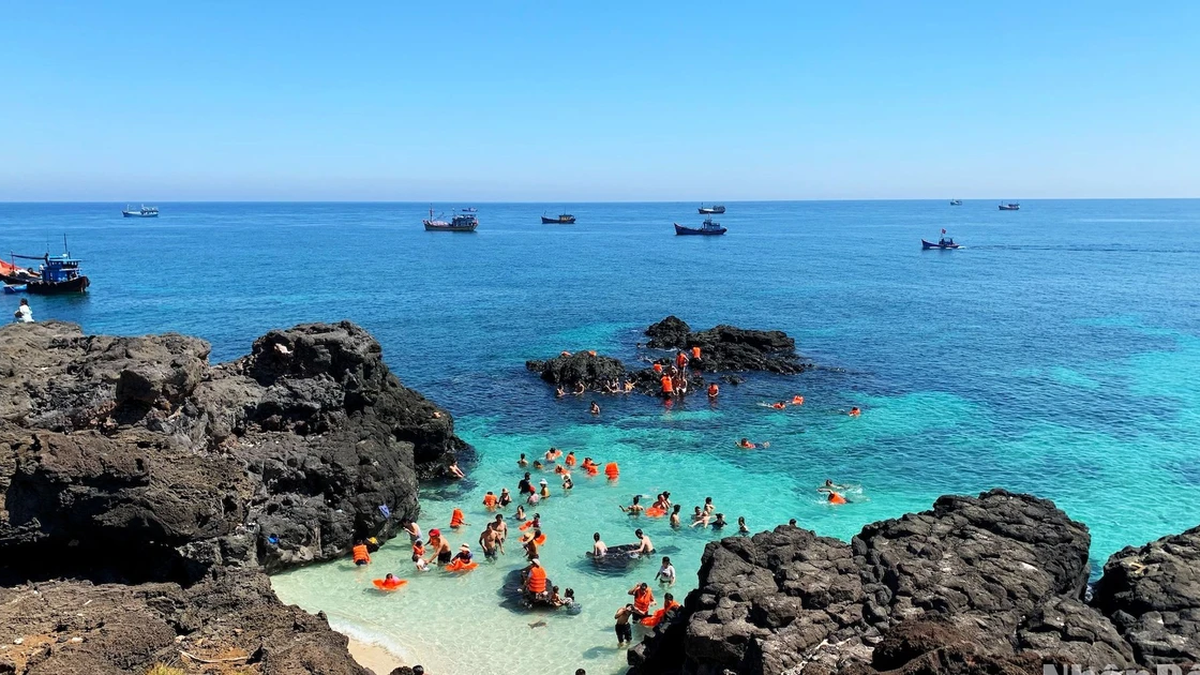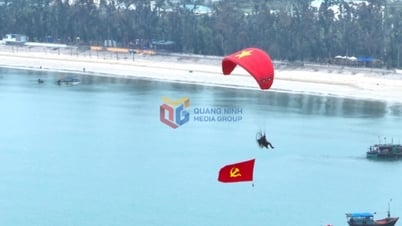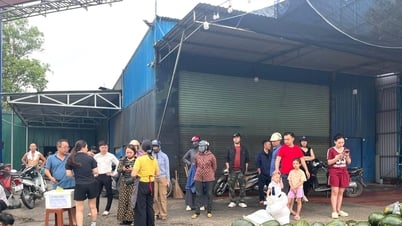The sharp increase in sea freight rates from Vietnam to Europe or the US has caused many businesses to spend tens of thousands of dollars more when exporting goods, resulting in a sharp decline in profits.
Freight rates on key routes have recently increased. At one point, the price of each container to Europe was around $4,000 - $5,000, more than double the price at the end of last year. Freight to the US has increased similarly, to $6,000 - $7,000 per container. Freight rates to nearby regions such as China, Japan, South Korea and Southeast Asia have also increased by $1,000 - $2,000 per container.
This situation forces domestic export enterprises to accept paying more for each shipment leaving the sea, sadly watching the loss of profits and facing the worry of difficulty competing with rivals.

Every month costs hundreds of thousands of dollars more
Responding to reporters, the leader of a fruit export business in Dong Nai said that since the beginning of the year, each export shipment is no longer a complete joy for him. The reason is that he has not seen any profit but the additional costs are up to hundreds of thousands of USD per month. He said that his business exports nearly 100 shipments per month. Currently, the freight to Europe has increased by about 2,500 USD/container, and to the US it has increased by 3,500 - 4,500 USD/container.
" At the lowest cost, with an increase of 2,500 USD/container, we would have to spend about 250,000 USD more per month than before. That is not to mention the costs arising from longer sea routes in the context of the maritime industry being affected by geopolitical conflicts. Meanwhile, if we want to compete, the price of goods cannot be adjusted to increase accordingly, so businesses have to accept losses ," he calculated.
There are still many concerns, but Mr. Nguyen Dinh Tung, General Director of Vina T&T Group, still expressed his joy when in the past few days, shipping rates have decreased compared to previous days.
“ Last week, shipping rates for a container from Vietnam to the US were up to 8,600 - 8,700 USD/container, but this week it has dropped to about 6,000 USD/container. Although the price is still nearly double the 3,500 USD/container at the end of 2023, it also helps businesses "breathe" a little easier , "he shared.
According to Mr. Tung, the company exports 2-3 containers per day. Thus, each shipment costs more than ten thousand USD. If the company cannot negotiate with its partners and has to sign a sales contract and cover shipping costs, this cost will be "poured" onto the company, and the difficulty will be huge.
Mr. Nguyen Van Kich - Chairman of the Board of Directors and General Director of Cafatex Seafood Joint Stock Company (Can Tho), a company specializing in exporting seafood to the US and Europe - also informed that Vietnamese businesses are struggling to bear the burden of shipping costs. For each 40-foot container that can hold 15 - 22 tons of goods, the price will increase by nearly 100 million VND. " Many businesses are struggling to find ways to survive, such as asking for support from partners or switching to new markets. But this is not easy, some businesses have had to consider limiting exports ," he said.

Containers are on fire, paying high prices is also difficult to find space
Mr. Kich said that most Vietnamese export enterprises are having to accept paying sky-high sea freight rates because there are no alternatives, when the supply of containers is very scarce. " If the freight rate increases and there is a place on the ship, it is still lucky, but some companies do not have any place, which means that paying a high price is not certain to book a ship. The reason is that the Chinese market has too much demand and they are willing to pay higher freight rates to occupy space ," Mr. Kich said.
According to Ms. Ngo Tuong Vy, Director of Chanh Thu Company (Ben Tre), in recent years, shipping rates have experienced high increases each year and the main reason is the lack of empty containers in the context of the impact of COVID-19 or escalating political conflicts.
" Empty containers are concentrated in China due to higher costs, so in the near future it is predicted that there will be a shortage of empty containers in Vietnam, pushing shipping rates to continue to increase, " Ms. Vy predicted.
Sharing the same view, Mr. Dang Phuc Nguyen, General Secretary of the Vietnam Fruit and Vegetable Association, said that along with high freight rates, congestion at transit ports has disrupted the operations of the entire supply chain, especially export goods of Vietnamese enterprises, because Vietnam's export activities to large markets such as the US and the EU region... largely depend on foreign shipping lines.
In addition to the conflicts in the Middle East, Chinese customers are increasingly holding containers and booking in advance, causing shipping rates to skyrocket. The demand for empty containers in China is very high because this is a major exporting country. Therefore, Vietnamese businesses are facing a big challenge.
Mr. Truong Quoc Hoe, General Secretary of the Vietnam Fisheries Association, said that Vietnam's export activities to large markets such as the US and the EU region... depend on foreign shipping lines. Therefore, it is inevitable that some shipping lines will take advantage of the current shortage of ships to push up service prices.
“ When the situation is difficult, they withdraw ships, causing shortages. This leads to higher freight rates. Meanwhile, negotiating and discussing with shipping lines to “share” difficulties with export enterprises at this time is completely impossible, ” said Mr. Hoe.
Difficult to find alternative routes
The Ministry of Industry and Trade recently recommended that exporting enterprises should diversify their goods and use alternative routes to reduce costs. For example, they can ship goods by sea to ports in the Middle East, then use air, rail or road to continue transporting to Europe.
However, many opinions say that this is not easy to do.
Mr. Bach Khanh Nhut, Vice President of the Vietnam Cashew Association, analyzed: Traditionally, Vietnamese enterprises sign contracts with partners several months before exporting goods to the European market. Therefore, the recommendation of the Ministry of Industry and Trade is only suitable in cases where enterprises sign contracts for sale and purchase, seasonal sales, when sea transport is not feasible at too high a price, enterprises will choose to go another way.
For example, cashew businesses often sign contracts at least 3-4 months before delivery. During the signing process, the foreign partner buying and selling goods takes responsibility for transportation, chartering ships, renting containers, and appointing shipping companies. In very few cases, we are proactive in appointing shipping companies.
According to Mr. Nhut, a shipment of cashews exported from Vietnam to the UK by ship when arriving at a country's seaport to complete procedures was guaranteed by businesses with the local government.
" If according to the recommendation of the Ministry of Industry and Trade, goods are transported by sea to the Middle East and then transferred by air, rail or road to continue transporting to Europe, they will have to go through many ports and border gates. What will the transit procedures be like? Some countries even open the goods for inspection. So who will be responsible for this? Meanwhile, if transported by sea, the companies will be responsible for delivering the goods to partners and ensuring the time, " Mr. Nhut raised the issue.
Ms. Ngo Tuong Vy is also concerned: Agricultural products do not have a long shelf life, so shipping by sea for about 30-40 days is appropriate. If businesses transport goods by sea to ports in the Middle East, then use air, rail or road to continue shipping to Europe, the transit time may be extended by about 10-20 days.
" Not to mention, transportation from the Middle East to European countries by rail or road must go through border gates and is very strictly controlled, making goods susceptible to damage, " said Ms. Vy.
Mr. Nguyen Van Kich commented: " If businesses export to China, they can replace sea transport with road transport, but for businesses exporting to Europe and the US, there is no other way of transport to replace sea transport ."
Source


![[Photo] Prime Minister Pham Minh Chinh chairs a meeting of the Steering Committee for key projects in the transport sector.](https://vphoto.vietnam.vn/thumb/1200x675/vietnam/resource/IMAGE/2025/5/10/0f4a774f29ce4699b015316413a1d09e)


































































































Comment (0)